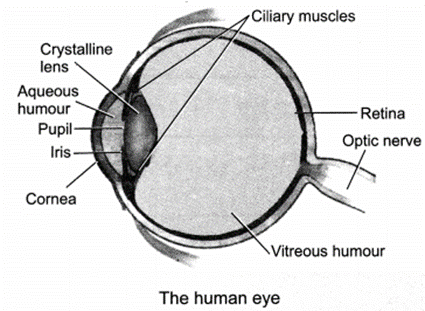- Books Name
- Iti Shree Science Book
- Publication
- Vaishnav Publication
- Course
- CBSE Class 10
- Subject
- Science
Chapter 11
Human Eye and colourful world
Human Eye
- It is one of the sensitive sense organs present in living organisms. It acts like a Camera.
- The image is formed on light sensitive screen known as Retina.
- Thin membrane through which light enters the eye is known as Cornea.
- The eyeball is spherical in shape.
- Presence of the crystalline lens helps in adjusting objects at different distances on the retina.
- The dark muscular structure that controls the size of the pupil is known as Iris. Thus, pupil regulates the amount of light entering the eye.
- Real, inverted image is formed on the retina. Retina contain light sensitive cells known as Rods and Cons. The light sensitive cells send signals to the brain via optic nerve.

Power of Accommodation:
Focal lens of the eye lens can be decreased or increased. The lens become thin when the muscles are relaxed. This increases the focal length. This helps to see the distant objects. Similarly, when the eye lens become thick, focal length decreases and we are able to see nearby objects.
So, power of accommodation is defined as ability of the lens to adjust the focal length.
- The minimum distance at which the particular object can be seen clearly is known as least distance of distinct vision. This is also called Near Point of the Eye. For young individuals, near point is about 25 cm. The farthest point to which an object can be seen is known as Far Point of the Eye. This is about 25 cm to infinity.
- In old age people, the lens becomes milky and cloudy, this is known as Cataract. This can leads to complete or partial loss of vision.
Defects of Vision
The three common defects of vision are as follows-
- Myopia (also known as Near Sightedness). In this case, distant objects cannot be seen clearly but nearby objects are clearly visible. Image is not formed on the retina, instead it is formed in front of the retina. Using concave lens of suitable power can be used to correct this defect.

Correction of Myopia
Hypermetropia also known as Far-sightedness. Nearby objects are not seen clearly whereas distant objects can be seen clearly. Image is formed behind the retina instead on the retina. Convex lens of appropriate power can be used to correct this defect.

Correction of Hypermetropia
- Presbyopia is defined as the one in which power of accommodation decreases with ageing. They have difficulty in near vision. Ciliary muscles get weakened and the flexibility of the eye lens gets diminished. Generally, bifocal lens are used for correcting the defects.

 Vaishnav Publication
Vaishnav Publication
